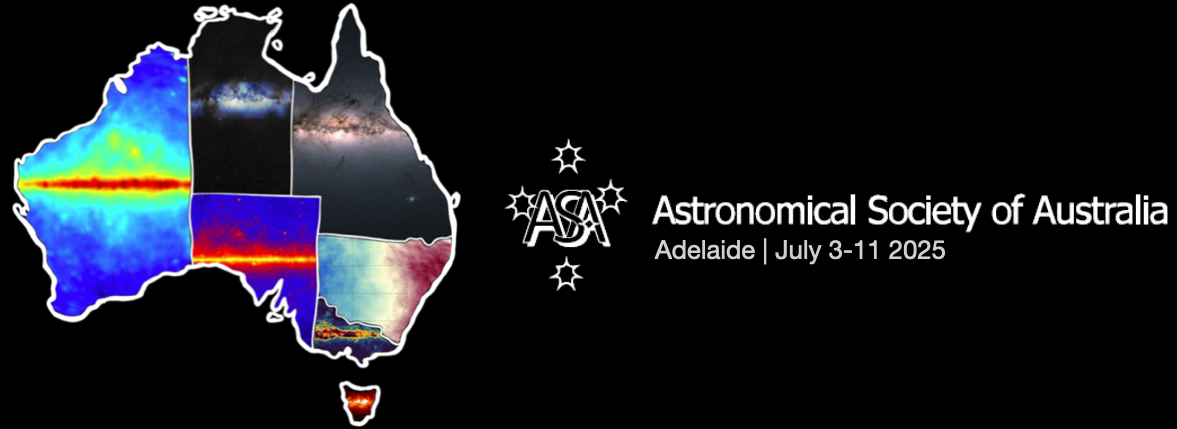Description
bla blah
Asymptotic Giant Branch (AGB) stars are known as key sites of dust production in the Galaxy. Most Sun-like stars with masses in the range 0.8 to 8 $M_\odot$ will pass through the AGB phase, during which they will lose a substantial amount of material. This mass loss is powered by radiation pressure through a pulsation-enhanced dust-driven wind. I will present new high angular resolution...
Post-giant binaries are unique systems that host stable circumbinary disks, formed from previously ejected stellar material, and exhibit unusual orbital characteristics resulting from complex binary interactions. Gas from the disk, which is deficient in heavy elements, is re-accreted onto the central stars, producing metal-poor surface abundances $\rm{-}$ a phenomenon known as chemical...
Protoplanetary discs (PPDs) of dust and gas around young stellar objects are now routinely imaged using high angular resolution facilities. Various substructures detected in these images serve as critical signposts of fundamental disc physics and inter-component interactions with the central star(s) or embedded sub-stellar companions. However, a certain class of evolved stars, called...
By now, most Australian astronomers have heard of the ever-evolving group known as GALAH*. With the recent drop of their fourth data release, it's the perfect time to revisit some of the standout tracks — and preview what’s next in this growing catalogue of Galactic hits.
Tracklist:
1. The Galactic Mashup: Decoding the Milky Way's merger history with GALAH observations and NIHAO-UHD...
The Sun — like many stars — possesses a wind that streams outwards to fill the heliosphere. Observations of the solar wind show that it is divided into “fast” and “slow” wind streams, whose variabilities, compositions and apparent origins are different. The origin of the slow solar wind remains enigmatic, hampering efforts to predict conditions in near-Earth space. Here we describe ongoing...
Magnetic active regions on the Sun's surface are the primary sources of significant solar activity. Understanding the physics behind the emergence of these active regions is essential for improving space weather forecasts, and understanding the underlying solar dynamo. Recent observational findings indicate that convection plays a crucial role in the emergence of active regions, challenging...
Observations of the surface of our Sun is one of the key ways to understand solar physics. The tracking of large-scale magnetic surface features, such as sunspots and plages, has provided insights into the solar dynamo, differential rotation, and other phenomena. Yet for most other stars, our knowledge of surface features—and consequently the stars themselves—remains severely limited,...
As observational studies of the Local Group and other environments have expanded to include smaller, fainter and more distant objects, it has become clear that the family of low-mass stellar systems is very diverse, encompassing normal and metal-complex globular clusters, ultra-faint dwarfs with extremely high mass-to-light ratios, and ultra-compact dwarf galaxies. This raises questions about...
Stellar streams – formed through the tidal disruption of dwarf galaxies and star clusters – can tell us about the nature of their progenitors as well as the distribution of mass inside their orbits. The Southern Stream Stellar Spectroscopic Survey (S5) employs the Anglo-Australian Telescope (AAT) to study stellar streams, using photometric and proper-motion data to identify candidate member...
Small stellar systems merge and are accreted hierarchically to form large galaxies like the Milky Way. We see the evidence for this process all around us: dynamically, as stellar overdensities in phase space in the nearby Galaxy; chemically, in abundance patterns distinct from those of stars formed in situ within the Milky Way; and spatially, as stellar streams and tidally disrupting...
Stellar actions are widely assumed to be conserved for use of orbit reconstruction techniques in Galactic studies. However, the Milky Way disk is highly dynamic, with time-dependent, non-axisymmetric features such as transient spiral arms and giant molecular clouds (GMCs) driving fluctuations in the gravitational potential constantly perturbing stellar orbits. Using high-resolution...
We are expanding on previous work on globular cluster stars that have escaped into the halo field using the fourth data release from the Galactic Archaeology with HERMES (GALAH) survey. We use a purely kinematic selection to identify both red giant and dwarf stars on halo orbits and investigate the utility of GALAH light element abundances for identifying second-population GC stars in that...
In my talk, I will present the results from the first monitoring campaign of a Main-sequence Radio Pulse emitter, or MRP. MRPs are main-sequence OBA type stars that emit periodic radio pulses by the electron cyclotron maser emission mechanism. The extra-ordinary stability and simplicity of their magnetic fields set them apart from other magnetic stars on the stellar main-sequence, and also...
I will present WD40, a white dwarf first identified as a radio source using circular polarisation searches with ASKAP. WD40 has been observed over 40 times with ASKAP and is highly variable, with flux densities ranging from 1 mJy to 65 mJy. It has been detected 40 times in 15 minute, 888.5 MHz and 943 MHz ASKAP observations but has not been detected in ASKAP observations at higher frequencies...
Galactic outflows play a crucial role in star formation regulation and the redistribution of gas and metals throughout galaxies. The recent discovery of high-velocity atomic and molecular clouds entrained in the Milky Way’s nuclear wind provides a unique opportunity to study these processes at sub-parsec resolution. Although cold clouds are commonly observed in galactic nuclear winds, their...

